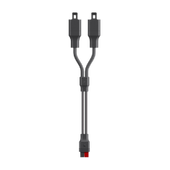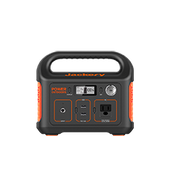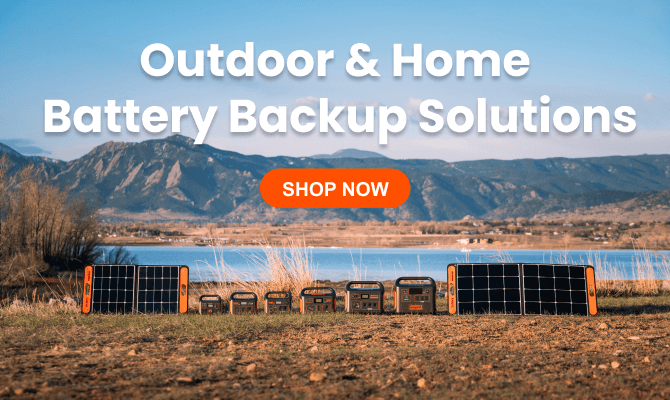One of the most loved outdoor activities is camping with family and loved ones. Many people set off on long family trips, stopping at beautiful and soul-healing camping sites to enjoy summer holidays. Instead of sweating in cramped tents, most people prefer RVs due to their safety and AC unit. An RV helps you relax and enjoy nature while staying cool in the summer heat.
However, using fuel to power the RV air conditioner is extremely costly. You typically need a 2000 - 4000W generator to charge an RV AC with BTU ratings lying between 10,000 - 15,000. Using a solar generator to power all of your RV appliances, including the AC unit, is the most cost-effective and reliable choice. This page tells you what size generator to run RV AC and the best Jackery products to adopt an off-grid RV lifestyle with clean solar energy.
Key Takeaways
Here is how to find out what size generator to run RV AC. The capacity of RV air conditioners (AC) determines the generator size, which is usually between 2,000 and 4,000 watts. Here are some estimated AC unit sizes and generator capacities:
10,000 BTUs (1,000 watts): A 2,000-watt generator should work.
13,500 BTUs (1,350 watts): Look for a generator with 2,200 to 3,000 watts.
15,000 BTUs (1,500 watts): Larger AC units need a 3,000 to 4,000-watt generator.
How Many Watts Does an RV AC Use?
Before deciding what size generator to run RV AC, it is essential to understand how much power the AC unit uses and which solar generator will be perfect for the job. Whenever we talk about the energy requirement for an air conditioner to remove heat from a room or an RV, the term that plays the most important role is BTU. The British thermal unit is a metric unit to measure the power needs of an AC unit to cool the required area.
To figure out how big of a generator to run RV AC, all you need is the BTU value, and you can easily convert it into watts to get an ideal number.
A commonly used approach when converting BTU into watts is using the precise conversion factor: 1 watt = 3.41 BTU per hour. For a 13,500 BTU unit, the wattage consumption will be 13,500 ÷ 3.41 = 3959 watts. However, the result we get appears quite higher than the typical range. This is because RV AC units are designed to be energy efficient. Hence, you can go with a typical range of 1000W to 1500W per 12,000 BTUs is appropriate.
Another way to calculate the wattage consumption is by using the EER (Energy Efficiency Ratio). The EER determines how efficiently an air conditioner converts electricity into cooling power. A typical EER for an RV AC conditioner ranges from 8 to 12. Similarly, you can calculate how big a generator is needed for a camper by determining how many watts are needed to run a camper's AC.
To help you determine the wattage consumption of RV AC units with different BTU ratings, we will use the EER of 10.
|
BTU |
Starting Wattage |
Running Wattage |
|
10000 |
3000W |
1000W |
|
13500 |
4050W |
1350W |
|
15000 |
4500W |
1500W |
What Size Generator Do You Need for An RV AC?
RV AC power consumption estimation:
To find out what size generator to run RV AC, Consider your RV's AC's BTU rating, which shows its cooling capability, to estimate its power usage. RV AC units usually feature a sticker or handbook with the relevant information. After getting the BTU rating, use these criteria to estimate operating and startup power:
Continuous wattage:
A typical RV AC uses 1350 watts, though it will depend on the BTU. Say your AC has 13,500 BTUs; you may estimate its operating power usage as follows:
For a 13,500 BTU RV air conditioner:
Power consumption = 13,500 BTUs / 10,000 BTUs per watt * 1000 watts = 1350 watts.
Initial (Surge) Wattage:
Startup wattage is typically 3 times the operating watts. Thus, for the 13,500 BTU AC unit:
Starting Wattage = 3 * 1350W = 4050W (roughly).
Finding the Right Generator Size:
You must consider your AC unit's operating and starting power and any other appliances and equipment you want to operate to determine the generator size required. The formula for calculating minimum generator size:
Total Wattage = AC Running Wattage + AC Starting Wattage + Other Appliance Power Requirements
This example shows how to calculate generator size:
RV AC unit: 13,500 BTU (estimated above)
AC starts at 4050 watts.
AC runs at 1350 watts.
Other appliances: A 1,200-watt microwave and a couple of 100-watt bulbs total 1,300 watts.
When calculating the generator size, you only need to add the running wattage of the appliances. In this case,
Total Wattage = 1350 (RV AC) + 1,300 (other appliances) = 2650W
To be safe, add 20% to 25% to the overall wattage:
Total Wattage with Safety Margin = Total Wattage * 1.2 (20% safety margin) to 1.25 (25% safety margin)
1.2 * 2650W = 3180 watts to 1.25 * 2650W = 3312 watts.
Therefore, a generator of 2,000 to 4000 W is needed to power your RV AC unit and other equipment securely. The generator you choose should have a surge wattage of at least 4050W to safely charge the RV AC. Keep in mind that all numbers are estimates, and electricity needs may vary. Always check your AC unit's requirements and talk to a generator or RV professional for the best generator size for your needs.
|
Room Size |
Area (Square Feet) |
BTU |
Generator Wattage Needed |
|
20x30 |
600 |
14000 |
3000-3200 |
|
20x20 |
400 |
12000 |
2600-2900 |
|
15x20 |
300 |
10000 |
2200-2600 |
|
10x20 |
200 |
8000 |
1400-2100 |
Here are a few common questions regarding the size of RV AC and what size generator you need:
Will a 2200 watt generator run an RV air conditioner? – If the RV AC consumes lower than 2000W, it's best to consider a 2200-watt generator.
Will a 3500 watt generator run an RV air conditioner? – A 3500-watt generator can run an RV AC consuming up to 3000W.
Will a 2000 watt generator run an RV air conditioner? – Yes, if the RV AC consumes around 2000W, then you can consider a 2000-watt generator.
Will a 1200-watt generator run an air conditioner? – A 1200W generator might not be favorable for running RV AC. Instead, you can use a 1200-watt generator to run other smaller RV appliances, like portable coolers, fans, etc.
What Size Generator Needed for RV With 2 AC Units?
An average sized RV typically consumes 600 - 1700W of electricity per hour. If you've two RV AC units, you'll probably need around 1200 - 3400W of electricity. A 4000-watt or 6000-watt generator is ideal for charging two AC units in an RV.
What Size Generator Needed for a 30 Amp & 50 Amp RV Air Conditioner?
A 2,500-3,000-watt solar generator is often a good minimum threshold for 30-amp RVs that have AC units. On the other hand, a 50-amp RV with 120V of power can manage up to 12,000 watts of electrical current (120 volts x 50 amps). Hence, a 12,000-watt generator can easily provide sufficient power in place of your RV's main power systems.
What Types of Generator Needed to Run An RV AC?
If you want to know what size generator to run RV AC, you need to figure out which type of generator you want. You can use different types of generators to power an RV air conditioner, each with its own set of pros and cons. These include gas generators, propane generators, inverter generators, and solar generators.
RV Power Generators: All Types
Gas Generator:
A gas generator uses gasoline as its fuel source. It uses a gasoline-powered internal combustion engine, which converts the fuel into energy.
Pros:
- The fuel (gasoline) is readily accessible and widely supplied.
- It is cheap compared to other generators.
- It is able to power several home electronics at once.
Cons:
- It can be loud, perhaps upsetting your camping experience.
- Possible high fuel usage means more frequent stops for gas and more running costs.
- Air pollution from vehicle exhaust is something to consider while setting up camp.
Portable Generators:
Propane generators run on propane gas. It generates power for recreational vehicles by burning propane gas.
Pros:
- It is eco-friendly and has a low carbon footprint when burned.
- Longer run duration and lower fuel usage compared to gas-powered alternatives.
- Lower noise levels than comparable gas-powered alternatives.
Cons:
- It's possible that propane is less accessible than gasoline.
- There might be extra costs for both setup and upkeep.
- Needs related to fuel storage and management.
Inverter Generator:
The term "inverter generator" refers to a specific kind of generator that employs cutting-edge technology to reliably provide clean electricity. The fuel economy and quietness are both enhanced by the variable-speed engine generally seen in such vehicles.
Pros:
- Modern engineering and effective acoustic insulation allow for silent operation.
- These reduce power consumption.
- Produces clean and reliable power, excellent for delicate devices.
Cons:
- The initial investment is more than that of more traditional power sources.
- Fewer watts are produced than bigger gas or propane generators.
- High-draw gadgets and massive air conditioners could not work.
Solar Generator:
A solar generator is a system that uses solar panels to absorb energy from the sun and store it in batteries. This energy transforms into electricity for use in a wide range of settings and to power appliances.
Pros:
- Renewable energy is clean and sustainable.
- Zero noise and exhaust emissions while operating.
- After installation, the system seldom needs any attention and costs very little to run.
Cons:
- Solar panels and batteries have a high outlay for the initial setup.
- These provide limited effectiveness on cloudy days or in places with heavy overcast.
|
Types of Generators |
Pros |
Cons |
|
Gas Generator |
Widely available and lower upfront cost. |
Noisy, high fuel consumption, emissions. |
|
Propane Generator |
Clean-burning and efficient, quieter operation. |
Propane availability, higher initial/maintenance costs. |
|
Inverter Generator |
Quiet, fuel-efficient, clean power output. |
Higher initial cost, limited power output. |
|
Solar Generator |
Clean, renewable energy source. Silent operation. |
High initial setup cost, sunlight dependence, and limited capacity. |
How Does a Generator Work With AC Units?
A generator powers an RV air conditioning system by providing electricity similar to power coming from the grid to run your home appliances. Here is an outline of its operation:
Burning fuel:
Generators create electricity from fuel, propane, or solar power. Gas or propane generators use internal combustion engines to generate mechanical energy. Solar generators use photovoltaic panels to turn sunlight into electricity. Mechanical energy generates electrical energy to spin an alternator or generator head rotor. Rotation generates current in generator wire windings.
Voltage Regulation:
Generators create AC currents. The generator supplies 120V AC, 60Hz in North America, to power AC equipment in homes and RVs. This voltage and frequency must be controlled. Electricity is distributed via the generator's outlets or distribution panel. RVs may have an onboard generator that connects directly to the electrical grid, whereas portable generators offer outlets for RVs and homes. Starting and operating the generator powers the AC unit by connecting it to the RV or home's electrical system.
Different Jackery Solar Generators For Power RV AC
Jackery solar generators and portable power stations provide clean, environment-friendly, and off-grid energy for your appliances. Here is how these generators work and provide you with green energy.
Jackery Solar Generators absorb sunlight, turn it into energy, store it in a battery, and distribute it via outlets to power electronics and appliances, including RV AC units. They are ideal for those who seek quiet, eco-friendly electricity for their RVs.

Here is how to calculate the working hours of Jackery Solar Generators.
Working Hours = Battery Capacity (WH) *0.85/ AC Unit Power (W)
Solar Generator 3000 Pro:

The Jackery Solar Generator 3000 Pro powers RV air conditioners with its large capacity. Its 3024Wh capacity and 2000-cycle life make it versatile for long outdoor trips. It charges via solar panels, wall outlets, automobile adapters, or generators. The power station provides clean, quiet power for sensitive equipment via AC outlets, USB connections, and automobile charging. RV owners and outdoor lovers looking for dependable, eco-friendly electricity choose it because it is lightweight, portable, and has a reliable lithium-ion battery that will last for many years to come.
|
Product |
Solar Generator 3000 Pro |
|
Capacity |
3024 WH |
|
Cycle Life |
2000 cycles to 70% + capacity |
|
Dimension |
Length=18.6 in, Width=14.1 in, Height=14.7 in |
|
Recharging Methods |
Solar panels, wall outlet, car, generator |
|
Output Ports |
AC outlet, USB-C, USB-A, carport, DC outlet |
|
Working Hours |
10,000BTUs (1000W): (3024*0.85/1000) = 2.5H approx. 13,500BTUs (1350W): (3024*0.85/1350) = 1.9H approx. 15,000BTUs (1500W): (3024*0.85/1500) = 1.7H approx. |
Solar Generator 2000 Plus:

The 2042WH Jackery Solar Generator 2000 Plus is a small and adaptable portable power station for outdoor and emergency electricity. You can charge it with solar panels, a power socket, a vehicle adaptor, or a generator. The power station provides clean, quiet power for sensitive gadgets via AC, USB, and automobile charging connectors. It provides a peak power of 4000W and is ideal for RV AC units.
|
Product |
Solar Generator 2000 Plus |
|
Capacity |
2042 WH |
|
Cycle Life |
4000 cycles to 70% + capacity |
|
Dimension |
Length=14.7 in, Width=18.6 in, Height=14.1 in |
|
Recharging Methods |
Solar panels, wall outlet, car, generator |
|
Output Ports |
AC outlet, USB-C, USB-A, carport, DC outlet |
|
Working Hours |
10,000BTUs (1000W): (2042*0.85/1000) = 1.7H approx. 13,500BTUs (1350W): (2042*0.85/1350) = 1.2H approx. 15,000BTUs (1500W): (2042*0.85/1500) = 1.1H approx. |
Solar Generator 2000 Plus Kit (4kWh):

The Jackery Solar Generator 2000 Plus Kit (4kWh) is a portable and powerful charging solution that can charge most RV ACs for hours. It typically features double wheels, foldable handle, and ergonomic design to move in and out of the RV whenever required. The LiFePO4 battery of the solar generator ensures safe charging of RV AC and other 99% of your RV appliances.
|
Product |
Solar Generator 2000 Plus Kit (4kWh) |
|
Capacity |
4085.6 WH |
|
Cycle Life |
4000 cycles to 70% + capacity |
|
Dimension |
Length=14.7 in, Width=18.6 in, Height=14.1 in |
|
Recharging Methods |
Solar panels, wall outlet, car, generator |
|
Output Ports |
AC outlet, USB-C, USB-A, carport, DC outlet |
|
Working Hours |
10,000BTUs (1000W): (4085.6*0.85/1000) = 3.4H approx. 13,500BTUs (1350W): (4085.6*0.85/1350) = 2.5H approx. 15,000BTUs (1500W): (4085.6*0.85/1500) = 2.3H approx. |
How to Maximize Generator and RV AC Efficiency?
After finding out what size generator to run RV AC, here is how you can maximize generator and RV AC unit efficiency.
- Use a suitable generator to reduce waste.
- Perform frequent maintenance for best results.
- To save running costs, consider a solar generator.
- Match engine speed to load using eco-mode.
- Avoid engine problems with high-quality gasoline.
- Avoid overloading and distribute power well.
- Ventilate and cool the generator.
AC Efficiency Dos and Don'ts:
- Set the AC to a comfortable temperature.
- Maintain clean AC filters and RV insulation.
- Cover windows and park in the shade.
- Increase ventilation to cut AC use.
- Do not operate the AC on low power.
- Keep doors and windows closed while cooling.
- Avoid using power-hungry devices simultaneously.
- Keep cool air in your RV by sealing leaks.
- Turn off the AC when not in use and prevent severe heat.
FAQs
What size generator to run 15,000 BTU RV AC?
When deciding the generator size, you need to know how many watts a 15000 BTU air conditioner uses. A 15,000 BTU AC typically consumes 1500W, and a generator size of 2000W - 3000W would work for you.
How much does it cost to run an RV air conditioner?
The cost to run an RV air conditioner will depend on the wattage of the RV AC, how long you use it, and the electricity rate. For example, if you are running a 10,000 BTU RV AC (1000W) for 6 hours per day, it will consume around 6000Wh or 6kWh per day. If the electricity rate is $0.16 per kWh, the total monthly bill will be $28.8.
How many watts generators are needed to run a 13,500 BTU air conditioner?
For a 13,500 BTU air conditioner consuming 1350W electricity, a solar generator of around 2200 - 3000W would work great.
Final Thoughts
Let’s conclude our guide on what size generator to run RV AC here. Before you purchase a generator for your RV AC, the first thing to do is to figure out which type of generator you want. Although gas generators are a popular choice, Jackery Solar Generators are the best option as they provide clean energy for free. Jackery is the world's leading portable power system producer that offers reliable and high-quality solar generators. Enjoy an off-grid lifestyle and outdoor activities with Jackery solar generators.




















































































































According to your table up there, I could only run an AC on solar for a few hours a day?
I would love to run my RV AC on solar power, but it looks like your table above says it would only run it for 2 or 3 hours?__
Leave a comment